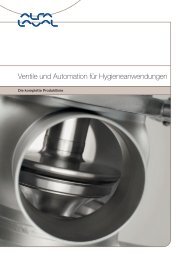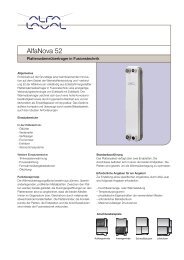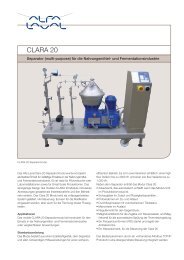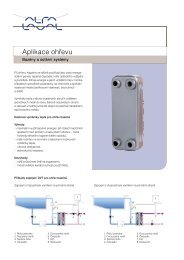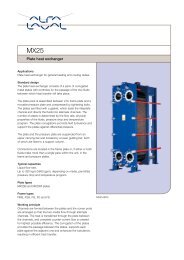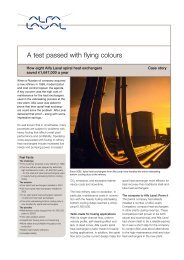The hygienic condenser.pdf - Alfa Laval
The hygienic condenser.pdf - Alfa Laval
The hygienic condenser.pdf - Alfa Laval
Create successful ePaper yourself
Turn your PDF publications into a flip-book with our unique Google optimized e-Paper software.
<strong>The</strong> <strong>hygienic</strong> <strong>condenser</strong><br />
Compabloc<br />
In the pharmaceutical industry there is a requirement for<br />
high quality <strong>condenser</strong>s - used as overhead <strong>condenser</strong>s on<br />
reactors as well as vent <strong>condenser</strong>s.<br />
This requirement can be met with the welded and fully drainable<br />
<strong>hygienic</strong> Compabloc <strong>condenser</strong>. <strong>The</strong> design, compared<br />
to the conventional Compabloc, involves a new concept of<br />
baffles and lateral end plates without any retention of<br />
condensate. Electropolishing can also be offered on request<br />
in order to improve surfce finish of process contact surfaces.<br />
Applications<br />
Pharmaceuticals, fine chemicals and speciality chemicals.<br />
Duty<br />
Condensing duties with or without non-condensable gases.<br />
Low vacuum, atmospheric or higher pressures.<br />
Unique design<br />
<strong>The</strong> Compabloc <strong>condenser</strong> has an innovative design, completely<br />
different from traditional shell-and-tube <strong>condenser</strong>s.<br />
It represents a quantum leap in process capability and cost<br />
savings.<br />
Vapour<br />
Cooling media<br />
Condensate<br />
<strong>The</strong> Compabloc is built around a core of corrugated heat<br />
transfer plates. <strong>The</strong>se plates are welded alternately to form<br />
channels. <strong>The</strong> complete plate pack slides inside a four-<br />
column carbon steel frame bolted to pressure-retaining<br />
heads. Four removable panels contain the fluid inlet and<br />
outlet connections.<br />
<strong>The</strong> condensing side consists of straight-through channels<br />
with very short vapour paths, allowing for very low pressure<br />
drops. On the coolant side, baffles direct the cooling media<br />
back and forth through the channels in order to increase<br />
turbulence.<br />
<strong>The</strong> corrugated pattern in the <strong>condenser</strong> creates maximum<br />
turbulence, which in turn results in outstanding heat transfer<br />
efficiency. <strong>The</strong> overall heat transfer coefficient is two to four<br />
times greater than in a corresponding shell-and-tube unit.<br />
In other words, the <strong>condenser</strong> requires only 25-50% of the<br />
heat transfer area of an equivalent tubular unit. That, in<br />
essence, is the advantage of the Compabloc.
Vapour Vapour Non-condensable gas Non-condensable gas<br />
Condensate<br />
Condensate<br />
Vapour<br />
Single-pass <strong>condenser</strong> Two-pass <strong>condenser</strong> with inert gas sub-cooling Reflux <strong>condenser</strong><br />
Working principles<br />
In operation, the vapour enters the unit and condenses on<br />
the cold plate while passing through the plate pack. <strong>The</strong><br />
condensate is extracted from the bottom of the unit. <strong>The</strong><br />
cooling media is forced through several passes with a series<br />
of baffles. This, together with the plate corrugations,<br />
maximises heat transfer efficiency and minimizes fouling.<br />
<strong>The</strong> <strong>hygienic</strong> Compabloc can be fitted to any condensing<br />
duty. If the vapour contains non-condensable gases, a twopass<br />
arrangement on the condensing side can be used. <strong>The</strong><br />
second pass enables sub-cooling of the non-condensable<br />
gases, thus condensing as much as possible. <strong>The</strong> two-pass<br />
arrangement permits gas/liquid separation inside the unit,<br />
eliminating any need for an additional vapour separator. <strong>The</strong><br />
main condensation takes place in the first pass. <strong>The</strong> sub-<br />
cooling of the non-condensable gases is achieved in the<br />
second pass, while also serving as a mist eliminator. <strong>The</strong><br />
two-pass arrangement works like two <strong>condenser</strong>s in series.<br />
<strong>The</strong> Compabloc can be mounted directly on top of a reactor,<br />
for example, as a reflux <strong>condenser</strong>. In the reflux design, the<br />
vapour enters from the bottom and condenses on the cold<br />
plates, with non-condensable gases being removed at the<br />
top, and the condensate flowing back to the reactor.<br />
Two-in-one solution<br />
Also available is a special design of the <strong>hygienic</strong> Compabloc<br />
<strong>condenser</strong>; a <strong>condenser</strong> working with two different cooling<br />
medias.<br />
Two cooling media<br />
<strong>condenser</strong><br />
PLS00103 EN 1104<br />
How to contact <strong>Alfa</strong> <strong>Laval</strong><br />
Contact details for all countries<br />
are continually updated on our website.<br />
Please visit www.alfalaval.com to<br />
access the information direct.<br />
Condensate<br />
<strong>The</strong> first section works as a main <strong>condenser</strong>, followed by a<br />
gas/liquid separation in the bottom of the unit. <strong>The</strong> vapours<br />
not condensed go on to the second section, working as a<br />
vent <strong>condenser</strong>, where the cooling media is much colder. This<br />
extremely compact construction allows for main and vent condensation<br />
in a single unit, providing savings in piping, space<br />
and a lower VOC content.<br />
Hygienic standard design on process circuit<br />
• Full drainability.<br />
• Plate pack acid pickled and passivated.<br />
• Complete process circuit acid pickled and passivated<br />
by recirculation.<br />
• Helium leak test.<br />
• Surface roughness, Ra < 0.8 µm, on process circuit.<br />
• Electropolished plates (SS 316L, Alloy C22).<br />
Options<br />
• Electropolished plate pack after welding (SS 316L).<br />
Materials<br />
Standard: SS 316L and Alloy C22.<br />
On request: Alloy C276, C2000 and Tantalum.<br />
Cover gaskets in Gylon blue (PTFE).<br />
Design codes<br />
AD-2000 AD merkblatt design for CE-marking (PED).<br />
ASME VIII Div. 1 design (with U-stamp option).<br />
Technical specifications<br />
Design pressure: FV to 16 barg (232 psig).<br />
Design temperature: -40 o C (-40 o F) / 200 o C (392 o F) for PED.<br />
-45 o C (-49 o F) / 200 o C (392 o F) for ASME.<br />
Models<br />
CP2M15, CP2M20, CP2M30, HCP15, HCP20, HCP30 and<br />
HCP40.





